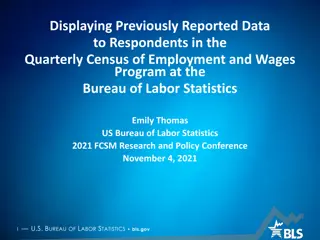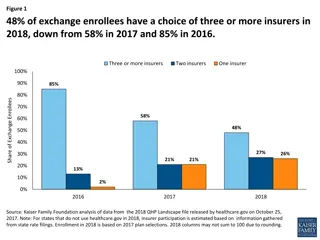Non-Metro Employment Trends Before and During COVID-19
Significant changes in non-metro employment levels before and during the COVID-19 era, analyzing key findings, industry sectors most affected, and the impact on provinces. Understand the implications of the pandemic on rural and small town areas.
Download Presentation

Please find below an Image/Link to download the presentation.
The content on the website is provided AS IS for your information and personal use only. It may not be sold, licensed, or shared on other websites without obtaining consent from the author.If you encounter any issues during the download, it is possible that the publisher has removed the file from their server.
You are allowed to download the files provided on this website for personal or commercial use, subject to the condition that they are used lawfully. All files are the property of their respective owners.
The content on the website is provided AS IS for your information and personal use only. It may not be sold, licensed, or shared on other websites without obtaining consent from the author.
E N D
Presentation Transcript
Non-metro employment in the months BCE (before Covid era or before coma economy) and in the months CE (Covid era or coma economy) Selected charts up to May, 2020 June 5, 2020 Ray D. Bollman RayD.Bollman@sasktel.net Research Associate, Rural Development Institute, Brandon University Professional Associate, Leslie Harris Centre of Regional Policy and Development, Memorial University
Non-metro employment A. Key findings B. Introduction C. Definitions Note: Published data for each month for each metro area is a 3-month moving average (and it is these data that we use to calculate the metro and non-metro levels of employment). Thus, the published data for May (which is a 3-month average for Mar/Apr/May) would be expected to completely capture the impact of COVID-19 on employment levels. D. Canada: 3 measures of number & change in number employed 1. Trends and change using a 12-month moving average 2. Change comparing a given month to the average for the same month in the three previous years 3. Change on a month-to-month basis C. Change in number employed by province D. Change in number employed by industry sector E. Context 2 RayD.Bollman@sasktel.net
Key findings: Trends and change in employment in Metro (CMA) and Non-metro (Non-CMA) areas Note: For metro and non-metro data, the published numbers for each month are a 3-month average for example, the published data for May 2020 is an average of Mar 2020 & Apr 2020 & May 2020. Thus, the May 2020 numbers would be expected to completely capture the impact of COVID-19 on non-metro employment as the months of Mar/Apr/May were the months of extensive closures across Canada (see next slide) From Feb to May 2020 (data for each month is a 3MMA), the non-metro job loss was 411,000 The Feb to May 2020 employment decline in non-metro was less (-8.9%) compared to metro areas (-12.9%). From Feb to May 2020 (data for each month is a 3MMA), the industry sectors with the largest NON-METRO decline in the NUMBER employed were: Accommodation and food services, down 95,000 jobs Retail and wholesale trade. . . . .. . . .down 83,000 jobs Construction . . . . . . . . . . . . . . . . . . . down 46,000 jobs From Feb to May 2020 (data for each month is a 3MMA), the industry sectors with the largest NON-METRO PERCENT decline in employment were: Accommodation and food services, down 37.4% Retail and wholesale trade . . . . . . . .down 12.0% Educational services . . . . . . . . . . . . . down 11.7% From Feb to May 2020 (data for each month is a 3MMA), the provinces with the largest NON- METRO PERCENT decline in employment were: Quebec, down 12.8%; Nova Scotia, down 11.7%; and Newfoundland and Labrador, down 9.1% 3 RayD.Bollman@sasktel.net
Employment in rural and small town areas Introduction -- COVID-19 timeline Dec. 31, 2019: China informs the World Health Organization (WHO) of a cluster of 41 patients with a mysterious pneumonia. Jan. 23, 2020:The city of Wuhan is placed under quarantine and a few days later, so is the entire province of Hubei. Mar. 11, 2020: The WHO declares a pandemic; the global confirmed case count is 126,000. Mar. 12 (Quebec) to Mar. 22 (Nova Scotia), every Canadian province and territory had declared a state of emergency, with gradually tightening restrictions. Mar.15-21: Enumeration of March employment levels for the Labour Force Survey. Much of the impact of COVID-19 appeared in the March data Mar. 21: U.S.-Canada border officially closes to non-essential travel Apr. 12-18: Enumeration of April employment levels for the Labour Force Survey. The full impact of the impact of COVID-19 appeared in the April data. May 17-26: Enumeration of May employment levels for Labour Force Survey. Only a few establishments in a few provinces had re-opened by this time THUS: COVID-19 impact on data enumerated by the LFS Feb 2020 LFS: employment was still in the state of the old normal Mar 2020 LFS: the bulk of the COVID-19 shutdown had occurred Apr 2020 LFS: the complete impact of COVID-19 May 2020 LFS: a few scattered re-openings were occurring 4 RayD.Bollman@sasktel.net
Definitions Labour Force Survey (LFS) 1. Data on employment from the monthly LFS during the third of May, 2020 was published on June 5, 2020. 2. Number employed: Number of persons who, during the reference week, worked for pay or profit, or performed unpaid family work or had a job but were not at work due to own illness or disability, personal or family responsibilities, labour dispute, vacation, or other reason. Those persons on layoff and persons without work but who had a job to start at a definite date in the future are not considered employed. Estimates in thousands, rounded to the nearest hundred. 3. The LFS rotates 1/6 of its sample every month. The data for the first month is typically collected via a face-to-face household interview but, for March, 2020, this was changed to a telephone (or maybe Internet) data collection approach. 4. Published data for each month for each metro area is a 3-month moving average (and it is these data that we use to calculate the metro and non-metro levels of employment). 5. Thus, the published data for May (which is a 3-month average for Mar/Apr/May) would be expect to completely capture the impact of COVID-19 on employment levels as the enterprises forced to shut down (or downsize) were closed in the 3rd week of each of March and April and May, 2020. 6. Metro and non-metro are defined in the next chart. 5 RayD.Bollman@sasktel.net
Metro refers to Census Metropolitan Areas (CMAs) which have a total population 100,000 or more (with at least 50,000 in the urban core) and includes all neighbouring towns and municipalities where 50+% of employed residents commute to the CMA. Non-metro refers to individuals who live outside a CMA. The current LFS data is based on the 2011 delineation of CMAs. Metro areas in each province, 2006, 2011 and 2016 Metro areas (CMAs) within each province Population in 2006 Census Population in 2011 Census Population in 2016 Census Province Newfoundland and Labrador St. John's 196,966 205,955 181,113 Prince Edward Island There are no CMAs in PEI Nova Scotia Halifax Moncton Saint John Montreal Quebec City Ottawa Gatineau (Quebec part) Sherbrooke Saguenay Trois-Rivi res Toronto Ottawa Gatineau (Ontario part) Hamilton Kitchener Cambridge Waterloo London St. Catharines Niagara Oshawa Windsor Barrie Greater Sudbury Kingston Guelph Brantford Thunder Bay Peterborough Belleville Winnipeg Saskatoon Regina Calgary Edmonton Lethbridge Vancouver Victoria Kelowna Abbotsford Mission 372,858 126,424 122,389 3,635,571 715,515 283,959 186,952 151,643 141,529 5,113,149 846,802 692,911 451,235 457,720 390,317 330,594 323,342 177,061 158,258 152,358 127,009 124,607 122,907 116,570 Not a CMA in 2006 or 2011 390,328 138,644 127,761 3,824,221 765,706 314,501 201,890 157,790 151,773 5,583,064 921,823 721,053 477,160 474,786 392,184 356,177 319,246 187,013 160,770 159,561 141,097 135,501 121,596 118,975 403,390 144,810 126,202 4,098,927 800,296 332,057 212,105 160,980 156,042 5,928,040 991,726 747,545 523,894 494,069 406,074 379,848 329,144 197,059 164,689 161,175 151,984 134,203 121,621 121,721 103,472 778,489 295,095 236,481 1,392,609 1,321,426 117,394 2,463,431 367,770 194,882 180,518 New Brunswick Quebec Ontario Manitoba 694,668 233,923 194,971 1,079,310 1,034,945 Not a CMA in 2006 or 2011 730,018 260,600 210,556 1,214,839 1,159,869 Saskatchewan Alberta 2,116,581 330,088 162,276 159,020 2,313,328 344,615 179,839 170,191 Britisth Columbia 6 RayD.Bollman@sasktel.net Source: Statistics Canada, Census of Population, 2006, 2011 and 2016.
Labour Force Survey (LFS) 1. Employment change may be shown in various ways: a. To remove the month-to-month variability and the season-to-season variability in the data, we first use a 12-month moving average (12MMA) and compare the calculated 12MMA level of employment in each month with the 12MMA level of employment in the same month in the previous year. This clearly illustrates non-metro job recessions (with a lag) compared to the incidence of job recessions in metro areas. b. To enable a more sensitive calculation, we then compared the level of employment in a given month with the average level of employment in the same month in the previous three years (e.g., level of employment in May, 2020 is compared to the level of employment averaged over May, 2017 and May, 2018 and May, 2019). c. A comparison of the published 3MMA month-to-month levels of employment is shown but some of the variability is due to the inherent variability of monthly LFS estimates; and the month-to-month variability introduced by seasonal fluctuations in employment. 7 RayD.Bollman@sasktel.net
Trends and change using a 12-month moving average Feb 2020 12MMA metro employment 14.17 million Mar 2020 12MMA metro employment 14.16 million Apr 2020 12MMA metro employment 14.09 million Map 2020 12MMA metro employment 13.96 million Feb 2020 12MMA non-metro employment 4.90 million Mar 2020 12MMA non-metro employment 4.90 million Apr 2020 12MMA non-metro employment 4.89 million May 2020 12MMA non-metro employment 4.85 million Percent change (using difference of logs) compared to same month in previous year (using 12MMA): Feb 2019 to Feb 2020 in Metro = +2.57% Mar 2019 to Mar 2020 in Metro = +2.32% Apr 2019 to Apr 2020 in Metro = +1.57% May 2019 to May 2020 in Metro = +0.36% Feb 2019 to Feb 2020 in Non-metro = +0.65% Mar 2019 to Mar 2020 in Non-metro = +0.57% Apr 2019 to Apr 2020 in Non-metro = +0.14% May 2019 to May 2020 in Non-metro = -0.65% 8 RayD.Bollman@sasktel.net
Employment in non-metro Canada varied between 4.8 and 4.9 million from 2007 to May 2020 Number employed (,000) (15 years of age and over) (using a 12-month moving average) 16,000 14,000 12,000 10,000 Metro* 8,000 Non-metro* 6,000 4,000 2,000 0 1998 2017 2019 1997 1999 2000 2001 2002 2003 2004 2005 2006 2007 2008 2009 2010 2011 2012 2013 2014 2015 2016 2018 2020 * Metro refers to Census Metropolitan Areas (CMAs) which have a total population 100,000 or more (with at least 50,000 in the urban core) and includes all neighbouring towns and municipalities where 50+% of employed residents commute to the CMA. * Non-metro refers to individuals who live outside a CMA. Source: Statistics Canada. Labour Force Survey, Tables 14-10-0022-01 and 14-10-0097-01. Chart by RayD.Bollman@sasktel.net 9 RayD.Bollman@sasktel.net
Employment in non-metro Canada was 4.41 million in May, 2020 (3-month average Mar/Apr/May) Number employd (,000) (15 years of age and over) 14,500 6,000 14,000 5,500 13,500 13,000 5,000 12,500 12,000 4,500 Metro* (12MMA) (LHS) Metro* (3MMA) (LHS)** 11,500 Non-metro* (12MMA) (RHS) Non-metro* (3MMA**) (RHS) 11,000 4,000 2014 2015 2016 2017 2018 2019 2020 * Metro refers to Census Metropolitan Areas (CMAs) which have a total population 100,000 or more (with at least 50,000 in the urban core) and includes all neighbouring towns and municipalities where 50+% of employed residents commute to the CMA. * Non-metro refers to individuals who live outside a CMA. ** Published data for each month is a 3-month moving average. Source: Statistics Canada. Labour Force Survey, Tables 14-10-0022-01 and 14-10-0097-01. Chart by RayD.Bollman@sasktel.net 10 RayD.Bollman@sasktel.net
General growth in non-metro employment at the Canada level (lengthy declines: June, 2009 to October, 2010 and July, 2015 to January, 2017) Percent change** in number employed (15 years of age and over) compared to same month in previous year (using a 12-month moving average) 4 3 2 1 0 -1 -2 Metro* Non-metro* -3 -4 2019 1997 1998 1999 2000 2001 2002 2003 2004 2005 2006 2007 2008 2009 2010 2011 2012 2013 2014 2015 2016 2017 2018 2020 * Metro refers to Census Metropolitan Areas (CMAs) which have a total population 100,000 or more (with at least 50,000 in the urban core) and includes all neighbouring towns and municipalities where 50+% of employed residents commute to the CMA. * Non-metro refers to individuals who live outside a CMA. ** Percent change is calculated as the difference in the logarithm of employment, times 100 Source: Statistics Canada. Labour Force Survey, Tables 14-10-0022-01 and 14-10-0097-01. Chart by RayD.Bollman@sasktel.net 11 RayD.Bollman@sasktel.net
General growth in non-metro employment at the Canada level (lengthy decline: July, 2015 to January, 2017) Percent change** in number employed (15 years of age and over) compared to same month in previous year (using a 12-month moving average) 4 3 2 1 0 -1 -2 Metro* Non-metro* -3 -4 2016 2014 2015 2017 2018 2019 2020 * Metro refers to Census Metropolitan Areas (CMAs) which have a total population 100,000 or more (with at least 50,000 in the urban core) and includes all neighbouring towns and municipalities where 50+% of employed residents commute to the CMA. * Non-metro refers to individuals who live outside a CMA. ** Percent change is calculated as the difference in the logarithm of employment, times 100 Source: Statistics Canada. Labour Force Survey, Tables 14-10-0022-01 and 14-10-0097-01. Chart by RayD.Bollman@sasktel.net 12 RayD.Bollman@sasktel.net
Change comparing a given month to the average for the same month in the three previous years Feb 2020 (3MMA) in Metro = +4.0% Mar 2020 (3MMA) in Metro = +1.7% Apr 2020 (3MMA) in Metro = -4.2% May 2020 (3MMA) in Metro = -10.0% Feb 2020 (3MMA) in Non-metro = +1.0% Mar 2020 (3MMA) in Non-metro = +0.3% Apr 2020 (3MMA) in Non-metro = -4.7% May 2020 (3MMA) in Non-metro = -9.0% 13 RayD.Bollman@sasktel.net
General growth in non-metro employment at the Canada level (Lengthy declines: March, 2009 to October, 2010 and February, 2015 to November, 2016) Percent change** in number employed (3MMA), compared to the average for the same month in the previous 3 years (15 years of age and over) 8 7 6 5 4 3 2 1 0 -1 -2 -3 -4 Metro* Non-metro* -5 -6 2019 1997 1998 1999 2000 2001 2002 2003 2004 2005 2006 2007 2008 2009 2010 2011 2012 2013 2014 2015 2016 2017 2018 2020 * Metro refers to Census Metropolitan Areas (CMAs) which have a total population 100,000 or more (with at least 50,000 in the urban core) and includes all neighbouring towns and municipalities where 50+% of employed residents commute to the CMA. * Non-metro refers to individuals who live outside a CMA. ** Percent change is calculated as the difference in the logarithm of employment, times 100 Source: Statistics Canada. Labour Force Survey, Tables 14-10-0022-01 and 14-10-0097-01. Chart by RayD.Bollman@sasktel.net 14 RayD.Bollman@sasktel.net
Change on a month to month basis (based on a 3MMA for each month): Metro employment: Feb 2020 (3MMA) = 14.13 million Metro employment: Mar 2020 (3MMA) = 13.78 million Metro employment: Apr 2020 (3MMA) = 13.06 million Metro employment: May 2020 (3MMA) =12.42 million Non-metro employment: Feb 2020 (3MMA) = 4.82 million Non-metro employment: Mar 2020 (3MMA) = 4.76 million Non-metro employment: Apr 2020 (3MMA) = 4.54 million Non-metro employment: May 2020 (3MMA) = 4.41 million Percent change (using difference of logs) from previous month (3MMA): Jan 2020 to Feb 2020 in Metro = -0.38% Feb 2020 to Mar 2020 in Metro = -2.5% Mar 2020 to Apr 2020 in Metro = -5.4% Apr 2020 to May 2020 in Metro = -4.9% Feb 2020 to May 2020 in Metro = -12.9% Jan 2020 to Feb 2020 in Non-metro = -0.5% Feb 2020 to Mar 2020 in Non-metro = -1.3% Mar 2020 to Apr 2020 in Non-metro = -4.7% Apr 2020 to May 2020 in Non-metro = -2.9% Feb 2020 to May 2020 in Non-metro = -8.9% 15 RayD.Bollman@sasktel.net
Wide seasonal swings in non-metro employment at the Canada level Percent change** in number employed*** compared to previous month (3MMA) (15 years of age and over) 3 2 1 0 -1 -2 -3 In April 2020, non-metro employment (3MMA) was down 4.7% compared to the previous month -4 Metro* Non-metro* -5 -6 2019 1997 1998 1999 2000 2001 2002 2003 2004 2005 2006 2007 2008 2009 2010 2011 2012 2013 2014 2015 2016 2017 2018 2020 * Metro refers to Census Metropolitan Areas (CMAs) which have a total population 100,000 or more (with at least 50,000 in the urban core) and includes all neighbouring towns and municipalities where 50+% of employed residents commute to the CMA. * Non-metro refers to individuals who live outside a CMA. ** Percent change is calculated as the difference in the logarithm of employment, times 100. *** Published data for each month is a 3-month moving average. Source: Statistics Canada. Labour Force Survey, Tables 14-10-0022-01 and 14-10-0097-01. Chart by RayD.Bollman@sasktel.net 16 RayD.Bollman@sasktel.net
Wide seasonal swings in non-metro employment at the Canada level Percent change** in number employed*** compared to previous month (3MMA) (15 years of age and over) 3 2 1 0 -1 -2 -3 In April 2020, non-metro employment (3MMA) was down 4.7% compared to the previous month -4 Metro* Non-metro* -5 -6 2016 2014 2015 2017 2018 2019 2020 * Metro refers to Census Metropolitan Areas (CMAs) which have a total population 100,000 or more (with at least 50,000 in the urban core) and includes all neighbouring towns and municipalities where 50+% of employed residents commute to the CMA. * Non-metro refers to individuals who live outside a CMA. ** Percent change is calculated as the difference in the logarithm of employment, times 100. *** Published data for each month is a 3-month moving average. Source: Statistics Canada. Labour Force Survey, Tables 14-10-0022-01 and 14-10-0097-01. Chart by RayD.Bollman@sasktel.net 17 RayD.Bollman@sasktel.net
Trends and change by province in Metro (CMAs) and Non-metro (Non-CMA) areas From Feb to May 2020 (data for each month is a 3MMA), the provinces with the largest NON-METRO ABSOLUTE decline in employment were: Quebec, down 147,000 jobs; Ontario, down 75,000 jobs; and Alberta, down 54,000 jobs. (Details in table in Slide 23). 18 RayD.Bollman@sasktel.net
Which provinces experienced the largest decline in non-metro employment from February to May, 2020? Percent change2 Change in number employed (,000), Feb 2020 to May 2020 Average number employed (,000) in 12 months1 from April, 2019 to May, 2020 Number employed in May1, 2020(,000) Compared to the average for the same month1 in the previous 3 years Change from Feb 2020 to May 2020 From April, 2020 to May1, 2020 Province Non- metro (non- CMA) Non- metro (non- CMA) Non- metro (non- CMA) Non- metro (non- CMA) Non- metro (non- CMA) Non- metro (non- CMA) Metro (CMA) areas Percent non- metro Metro (CMA) areas Metro (CMA) areas Metro (CMA) areas Metro (CMA) areas Metro (CMA) areas All All All All All All areas areas areas areas areas areas Ranking of provinces by size of absolute change in number employed (,000) from February to May1, 2020 4,277 3,058 1,219 29 3,795 2,717 1,078 -517 -370 -147 -4.1 -4.2 -4.0 -12.8 -12.8 -12.8 -10.9 -11.8 -8.6 Quebec 7,383 6,175 1,208 16 6,632 5,512 1,120 -857 -782 -75 -5.0 -5.5 -2.4 -12.2 -13.3 -6.5 -8.2 -8.5 -6.6 Ontario 2,300 1,623 676 29 2,052 1,429 623 -254 -200 -54 -4.6 -5.0 -3.6 -11.7 -13.1 -8.3 -12.0 -12.7 -10.3 Alberta British Columbia 2,510 1,839 670 27 2,234 1,619 615 -283 -243 -40 -4.6 -5.6 -1.8 -11.9 -14.0 -6.3 -11.0 -11.5 -9.6 459 239 221 48 412 215 196 -48 -23 -24 -3.7 -3.5 -3.9 -10.9 -10.3 -11.7 -9.6 -6.9 -12.5 Nova Scotia 573 318 256 45 521 286 235 -53 -31 -22 -3.6 -3.9 -3.2 -9.7 -10.2 -9.0 -8.9 -9.1 -8.7 Saskatchewan 647 442 205 32 599 410 189 -55 -38 -17 -3.3 -3.5 -2.8 -8.7 -8.7 -8.6 -7.5 -5.7 -11.2 Manitoba 353 145 207 59 321 134 188 -28 -12 -16 -2.0 -1.6 349.6 -8.4 -8.5 -8.3 -8.4 -6.0 -10.0 New Brunswick Newfoundland and Labrador 221 113 108 49 197 104 93 -18 -9 -9 -2.1 -1.8 -2.3 -8.5 -8.0 -9.1 -11.9 -7.4 -16.8 Prince Edward Island 1. Data for each month is an average for the previous 3 months (i.e. a 3-month moving average). 78 . . 78 100 70.6 . . 70.6 -6 . . -6 -1.0 . . -1.0 -7.7 . . -7.7 -4.2 . . -4.2 2. Percent change is calculated as the difference of logarithms x 100. Source: Statistics Canada. Labour Force Survey, Tables 14-10-0022-01 and 14-10-0097-01. 19 RayD.Bollman@sasktel.net
Trends and change by province in Metro (CMAs) and Non-metro (Non-CMA) areas From Feb to May 2020 (data for each month is a 3MMA), the provinces with the largest NON-METRO PERCENT decline in employment were: Quebec, down 12.8%; Nova Scotia, down 11.7%; and Newfoundland and Labrador, down 9.1% (Details in table in Slide 23). 20 RayD.Bollman@sasktel.net
Which provinces experienced the largest PERCENT decline in non-metro employment from February to May, 2020? Percent change2 Change in number employed (,000), Feb 2020 to May 2020 Average number employed (,000) in 12 months1 from April, 2019 to May, 2020 Number employed in May1, 2020(,000) Compared to the average for the same month1 in the previous 3 years Change from Feb 2020 to May 2020 From April, 2020 to May1, 2020 Province Non- metro (non- CMA) Non- metro (non- CMA) Non- metro (non- CMA) Non- metro (non- CMA) Non- metro (non- CMA) Non- metro (non- CMA) Metro (CMA) areas Percent non- metro Metro (CMA) areas Metro (CMA) areas Metro (CMA) areas Metro (CMA) areas Metro (CMA) areas All All All All All All areas areas areas areas areas areas Ranking of provinces by size of PERCENT change in number employed (,000) from February to May1, 2020 4,277 3,058 1,219 29 3,795 2,717 1,078 -517 -370 -147 -4.1 -4.2 -4.0 -12.8 -12.8 -12.8 -10.9 -11.8 -8.6 Quebec 459 239 221 48 412 215 196 -48 -23 -24 -3.7 -3.5 -3.9 -10.9 -10.3 -11.7 -9.6 -6.9 -12.5 Nova Scotia Newfoundland and Labrador 221 113 108 49 197 104 93 -18 -9 -9 -2.1 -1.8 -2.3 -8.5 -8.0 -9.1 -11.9 -7.4 -16.8 573 318 256 45 521 286 235 -53 -31 -22 -3.6 -3.9 -3.2 -9.7 -10.2 -9.0 -8.9 -9.1 -8.7 Saskatchewan 647 442 205 32 599 410 189 -55 -38 -17 -3.3 -3.5 -2.8 -8.7 -8.7 -8.6 -7.5 -5.7 -11.2 Manitoba 2,300 1,623 676 29 2,052 1,429 623 -254 -200 -54 -4.6 -5.0 -3.6 -11.7 -13.1 -8.3 -12.0 -12.7 -10.3 Alberta 353 145 207 59 321 134 188 -28 -12 -16 -2.0 -1.6 349.6 -8.4 -8.5 -8.3 -8.4 -6.0 -10.0 New Brunswick Prince Edward Island 78 . . 78 100 70.6 . . 70.6 -6 . . -6 -1.0 . . -1.0 -7.7 . . -7.7 -4.2 . . -4.2 7,383 6,175 1,208 16 6,632 5,512 1,120 -857 -782 -75 -5.0 -5.5 -2.4 -12.2 -13.3 -6.5 -8.2 -8.5 -6.6 Ontario British Columbia 1. Data for each month is an average for the previous 3 months (i.e. a 3-month moving average). 2. Percent change is calculated as the difference of logarithms x 100. Source: Statistics Canada. Labour Force Survey, Tables 14-10-0022-01 and 14-10-0097-01. 2,510 1,839 670 27 2,234 1,619 615 -283 -243 -40 -4.6 -5.6 -1.8 -11.9 -14.0 -6.3 -11.0 -11.5 -9.6 21 RayD.Bollman@sasktel.net
Number employed and percent change by type of geographic area, Canada and Provinces, February to May, 2020 Percent change2 Change in number employed (,000), Feb 2020 to May 2020 Average number employed in previous 12 months1 (,000) Number employed in current month1 (,000) Compared to the average for the same month1 in the previous 3 years Change from Feb 2020 to May 2020 From month to month1 Province Non- metro (non- CMA) Non- metro (non- CMA) Non- metro (non- CMA) Non- metro (non- CMA) Non- metro (non- CMA) Non- metro (non- CMA) Metro (CMA) areas Percent non- metro Metro (CMA) areas Metro (CMA) areas Metro (CMA) areas Metro (CMA) areas Metro (CMA) areas All All All All All All areas areas areas areas areas areas Feb 2020 Mar 2020 Apr 2020 May 2020 Feb 2020 Mar 2020 Apr 2020 May 2020 Feb 2020 Mar 2020 Apr 2020 May 2020 Feb 2020 Mar 2020 Apr 2020 May 2020 Feb 2020 Mar 2020 Apr 2020 May 2020 Feb 2020 Mar 2020 Apr 2020 May 2020 Feb 2020 Mar 2020 Apr 2020 May 2020 Feb 2020 Mar 2020 Apr 2020 "May 2020 Feb 2020 Mar 2020 Apr 2020 May 2020 Feb 2020 Mar 2020 Apr 2020 May 2020 Feb 2020 Mar 2020 Apr 2020 May 2020 226 225 224 221 78 79 79 78 466 466 464 459 357 357 356 353 115 115 114 113 . . . . . . . . 241 241 240 239 148 147 147 145 111 110 110 108 78 79 79 78 225 225 223 221 210 210 209 207 49 49 49 49 100 100 100 100 48 48 48 48 59 59 59 59 28 28 28 29 16 16 16 16 32 32 32 32 44 44 45 45 29 29 29 29 27 27 27 27 26 26 26 26 214 211 201 197 76.3 74.8 71.4 70.6 459 449 427 412 349 342 327 321 4,312 4,211 3,954 3,795 7,489 7,317 6,969 6,632 653 646 619 599 574 564 540 521 2,307 2,258 2,148 2,052 2,517 2,464 2,339 2,234 18,951 18,537 17,595 16,833 112 110 106 104 . . . . . . . . 239 235 223 215 145 143 136 134 102 101 95 93 76.3 74.8 71.4 70.6 221 214 204 196 204 200 191 188 1,226 1,203 1,122 1,078 1,196 1,187 1,147 1,120 206 203 194 189 257 253 243 235 677 673 646 623 655 651 626 615 4,819 4,759 4,540 4,409 -2,117 -1,707 . . . . . . -1.8 -2.2 -7.7 -11.9 7.4 5.9 0.7 -4.2 3.0 1.5 -4.1 -9.6 1.7 0.3 -4.7 -8.4 2.8 0.8 -5.8 -10.9 4.8 2.9 -2.3 -8.2 2.5 1.5 -3.2 -7.5 1.9 0.2 -4.3 -8.9 0.9 -1.2 -6.6 -12.0 2.4 0.2 -5.6 -11.0 3.2 1.3 -4.3 -9.7 1.3 -0.2 -5.3 -7.4 . . . . . . . . 4.4 3.4 -2.3 -6.9 2.8 1.5 -3.3 -6.0 2.1 -0.4 -6.7 -11.8 5.7 3.4 -2.2 -8.5 4.0 3.5 -1.1 -5.7 2.1 0.6 -4.3 -9.1 1.8 -1.0 -6.8 -12.7 3.9 1.1 -5.1 -11.5 4.0 1.7 -4.2 -10.0 -5.1 -4.3 -10.2 -16.8 7.4 5.9 0.7 -4.2 1.5 -0.6 -6.0 -12.5 1.0 -0.5 -5.7 -10.0 4.8 3.9 -3.3 -8.6 0.3 0.3 -3.1 -6.6 -0.7 -2.8 -7.6 -11.2 1.5 -0.3 -4.3 -8.7 -1.3 -1.8 -6.0 -10.3 -1.7 -2.4 -6.9 -9.6 1.0 0.3 -4.7 -9.0 Newfoundland and Labrador -1.7 -4.8 -2.1 . . -2.0 -4.7 -1.0 . . -2.2 -5.0 -3.7 . . -2.0 -4.4 -2.0 . . -2.4 -6.3 -4.1 . . -2.3 -4.9 -5.0 . . -1.1 -4.3 -3.3 . . -1.7 -4.4 -3.6 . . -2.1 -5.0 -4.6 . . -2.1 -5.2 -4.6 . . -2.2 -5.2 -4.4 -2.0 -4.2 -1.8 . . . . . . . . . . -1.6 -5.2 -3.5 . . -2.2 -4.5 -1.6 . . -2.6 -6.0 -4.2 . . -2.6 -5.2 -5.5 . . -0.9 -4.4 -3.5 . . -1.6 -4.7 -3.9 . . -2.8 -5.3 -5.0 . . -2.6 -5.8 -5.6 . . -2.5 -5.4 -4.9 -1.3 -5.5 -2.3 . . -2.0 -4.7 -1.0 . . -3.0 -4.8 -3.9 . . 341.0 342.9 349.6 -18 -9 -9 -8.5 -8.0 -9.1 Prince Edward Island -6 . . -6 -7.7 . . -7.7 Nova Scotia -48 -23 -24 -10.9 -10.3 -11.7 New Brunswick -28 -12 -16 -8.4 -8.5 -8.3 4,345 4,344 4,319 4,277 7,469 7,473 7,445 7,383 654 654 652 647 581 580 578 573 2,342 2,338 2,324 2,300 2,559 2,554 2,537 2,510 19,078 19,070 18,976 18,802 3,114 3,111 3,090 3,058 6,248 6,253 6,229 6,175 446 446 445 442 323 322 321 318 1,661 1,657 1,644 1,623 1,876 1,873 1,861 1,839 14,173 14,165 14,090 13,953 1,231 1,233 1,229 1,219 1,220 1,220 1,216 1,208 208 208 207 205 258 258 257 256 681 681 680 676 682 680 676 670 4,905 4,905 4,886 4,849 3,086 3,008 2,832 2,717 6,293 6,130 5,822 5,512 448 444 425 410 317 312 297 286 1,629 1,584 1,502 1,429 1,862 1,814 1,712 1,619 14,131 13,779 13,055 12,425 . . -1.8 -7.0 -4.0 . . -0.7 -3.4 -2.4 . . -1.6 -4.2 -2.8 . . -1.7 -4.1 -3.2 . . -0.6 -4.2 -3.6 . . -0.7 -3.8 -1.8 . . -1.3 -4.7 -2.9 Quebec -517 -370 -147 -12.8 -12.8 -12.8 Ontario -857 -782 -75 -12.2 -13.3 -6.5 Manitoba -55 -38 -17 -8.7 -8.7 -8.6 Saskatchewan -53 -31 -22 -9.7 -10.2 -9.0 Alberta -254 -200 -54 -11.7 -13.1 -8.3 British Columbia -283 -243 -40 -11.9 -14.0 -6.3 CANADA -411 -11.8 -12.9 -8.9 1. Data for each month is an average for the previous 3 months (i.e. a 3-month moving average). 22 RayD.Bollman@sasktel.net 2. Percent change is calculated as the difference of logarithms x 100. Source: Statistics Canada. Labour Force Survey, Tables 14-10-0022-01 and 14-10-0097-01.
Trends and change by industry sector in Metro (CMAs) and Non-metro (Non-CMA) areas From Feb to Apr 2020 (data for each month is a 3MMA), the industry sectors with the largest NON-METRO decline in the NUMBER employed were: Accommodation and food services, down 95,000 jobs Retail and wholesale trade. . . . .. . . .down 83,000 jobs Construction . . . . . . . . . . . . . . . . . . . down 46,000 jobs (Details are in table in Slides28-30) 23 RayD.Bollman@sasktel.net
Which sector in non-metro Canada experienced the largest absolute decline in employment from February to May, 2020 Percent change2 Average number employed in 12 months1 (,000) up to May, 2020 Change in number employed (,000), Feb 2020 to May 2020 Number employed1 in May, 2020 (,000) Compared to the average for the same month1 in the previous 3 years Change from Feb 2020 to May 2020 From month to month1 Industry sector Non- metro (non- CMA) Non- metro (non- CMA) Non- metro (non- CMA) Non- metro (non- CMA) Non- metro (non- CMA) Non- metro (non- CMA) Metro (CMA) areas Percent non- metro Metro (CMA) areas Metro (CMA) areas Metro (CMA) areas Metro (CMA) areas Metro (CMA) areas All All All All All All areas areas areas areas areas areas Sectors ranked by absolute change in number employed from February to May, 2020 Accommodation and food services 1,149 841 307 27 725 515 210 -485 -390 -95 -21.6 -24.2 -14.9 -51.2 -56.4 -37.4 -50.9 -55.1 -39.7 Wholesale and retail trade 2,795 2,074 721 26 2,451 1,800 651 -402 -319 -83 -5.6 -6.4 -3.5 -15.2 -16.3 -12.0 -13.3 -13.9 -11.6 1,452 999 453 31 1,247 857 390 -169 -123 -46 -3.5 -4.0 -2.4 -12.7 -13.4 -11.2 -10.0 -11.0 -7.5 Construction 1,358 1,038 321 24 1,292 985 307 -162 -123 -38 -4.3 -4.3 -4.4 -11.8 -11.8 -11.7 -5.7 -4.3 -10.0 Educational services 1,706 1,199 507 30 1,539 1,071 468 -161 -124 -37 -3.5 -4.0 -2.4 -9.9 -10.9 -7.6 -10.8 -12.0 -8.1 Manufacturing Health care and social assistance 2,482 1,779 703 28 2,324 1,640 684 -192 -166 -26 -3.1 -3.6 -2.2 -7.9 -9.7 -3.7 -3.4 -5.2 1.3 Transportation and warehousing 1,021 787 234 23 911 694 217 -116 -98 -18 -5.4 -6.0 -3.5 -12.0 -13.2 -8.0 -7.3 -6.2 -10.8 Forestry, fishing, mining, quarrying, oil and gas 320 119 201 63 293 115 178 -19 -8 -11 -1.4 -2.2 -0.9 -6.1 -6.5 -5.9 -11.3 -3.8 -15.8 793 566 227 29 675 460 215 -125 -114 -10 -7.4 -10.2 -1.1 -16.9 -22.2 -4.7 -17.3 -21.4 -8.1 Other (personal) services Buinsess, building and other support services 753 588 165 22 674 523 151 -55 -47 -9 -3.9 -4.9 -0.3 -7.9 -8.5 -5.7 -12.7 -14.9 -4.8 291 71 220 76 277.7 74.4 203.3 1 7 -5 1.9 9.0 -0.6 0.4 9.2 -2.6 0.0 11.3 -3.8 Agriculture Finance, insurance, real estate and leasing 1,222 1,052 170 14 1,207 1,043 164 -31 -27 -4 -0.7 -0.5 -1.8 -2.5 -2.5 -2.4 2.5 3.5 -3.2 137 93 43 32 133 95 37 -1 1 -2 -0.3 -1.9 4.0 -0.8 0.8 -5.0 -4.4 5.6 -26.1 Utilities 1,013 783 230 23 983 758 225 -12 -12 0 -0.3 -0.7 1.0 -1.2 -1.5 0.0 1.0 -0.4 5.9 Public administration Professional, scientific and technical servics 1. Data for each month is an average for the previous 3 months (i.e. a 3-month moving average). 2. Percent change is calculated as the difference of logarithms x 100. Source: Statistics Canada. Labour Force Survey, Tables 14-10-0022-01 and 14-10-0097-01. 1,559 1,352 207 13 1,505 1,301 204 -53 -53 0 -1.4 -1.2 -2.1 -3.4 -4.0 0.2 1.8 2.7 -4.2 24 RayD.Bollman@sasktel.net
Trends and change by industry sector in Metro (CMAs) and Non-metro (Non-CMA) areas From Feb to May 2020 (data for each month is a 3MMA), the industry sectors with the largest NON-METRO PERCENT decline in employment were: Accommodation and food services, down 37.4% Retail and wholesale trade . . . . . . . . down 12.2% Educational services . . . . . . . . . . . . . down 11.7% Details are in table in Slides 28-30) 25 RayD.Bollman@sasktel.net
Which sector in non-metro Canada experienced the largest PERCENT decline in employment from February to May, 2020 Percent change2 Average number employed in 12 months1 (,000) up to May, 2020 Change in number employed (,000), Feb 2020 to May 2020 Number employed1 in May, 2020 (,000) Compared to the average for the same month1 in the previous 3 years Change from Feb 2020 to May 2020 From month to month1 Industry sector Non- metro (non- CMA) Non- metro (non- CMA) Non- metro (non- CMA) Non- metro (non- CMA) Non- metro (non- CMA) Non- metro (non- CMA) Metro (CMA) areas Percent non- metro Metro (CMA) areas Metro (CMA) areas Metro (CMA) areas Metro (CMA) areas Metro (CMA) areas All All All All All All areas areas areas areas areas areas Sectors ranked by PERCENT change in number employed from February to May, 2020 Accommodation and food services 1,149 841 307 27 725 515 210 -485 -390 -95 -21.6 -24.2 -14.9 -51.2 -56.4 -37.4 -50.9 -55.1 -39.7 Wholesale and retail trade 2,795 2,074 721 26 2,451 1,800 651 -402 -319 -83 -5.6 -6.4 -3.5 -15.2 -16.3 -12.0 -13.3 -13.9 -11.6 1,358 1,038 321 24 1,292 985 307 -162 -123 -38 -4.3 -4.3 -4.4 -11.8 -11.8 -11.7 -5.7 -4.3 -10.0 Educational services 1,452 999 453 31 1,247 857 390 -169 -123 -46 -3.5 -4.0 -2.4 -12.7 -13.4 -11.2 -10.0 -11.0 -7.5 Construction Transportation and warehousing 1,021 787 234 23 911 694 217 -116 -98 -18 -5.4 -6.0 -3.5 -12.0 -13.2 -8.0 -7.3 -6.2 -10.8 1,706 1,199 507 30 1,539 1,071 468 -161 -124 -37 -3.5 -4.0 -2.4 -9.9 -10.9 -7.6 -10.8 -12.0 -8.1 Manufacturing Forestry, fishing, mining, quarrying, oil and gas 320 119 201 63 293 115 178 -19 -8 -11 -1.4 -2.2 -0.9 -6.1 -6.5 -5.9 -11.3 -3.8 -15.8 Buinsess, building and other support services 753 588 165 22 674 523 151 -55 -47 -9 -3.9 -4.9 -0.3 -7.9 -8.5 -5.7 -12.7 -14.9 -4.8 137 93 43 32 133 95 37 -1 1 -2 -0.3 -1.9 4.0 -0.8 0.8 -5.0 -4.4 5.6 -26.1 Utilities 793 566 227 29 675 460 215 -125 -114 -10 -7.4 -10.2 -1.1 -16.9 -22.2 -4.7 -17.3 -21.4 -8.1 Other (personal) services Health care and social assistance 2,482 1,779 703 28 2,324 1,640 684 -192 -166 -26 -3.1 -3.6 -2.2 -7.9 -9.7 -3.7 -3.4 -5.2 1.3 291 71 220 76 277.7 74.4 203.3 1 7 -5 1.9 9.0 -0.6 0.4 9.2 -2.6 0.0 11.3 -3.8 Agriculture Finance, insurance, real estate and leasing 1,222 1,052 170 14 1,207 1,043 164 -31 -27 -4 -0.7 -0.5 -1.8 -2.5 -2.5 -2.4 2.5 3.5 -3.2 1,013 783 230 23 983 758 225 -12 -12 0 -0.3 -0.7 1.0 -1.2 -1.5 0.0 1.0 -0.4 5.9 Public administration Professional, scientific and technical servics 1. Data for each month is an average for the previous 3 months (i.e. a 3-month moving average). 2. Percent change is calculated as the difference of logarithms x 100. Source: Statistics Canada. Labour Force Survey, Tables 14-10-0022-01 and 14-10-0097-01. 1,559 1,352 207 13 1,505 1,301 204 -53 -53 0 -1.4 -1.2 -2.1 -3.4 -4.0 0.2 1.8 2.7 -4.2 26 RayD.Bollman@sasktel.net
Number employed and percent change by industry sector and by type of geographic area, Canada, February to May, 2020 (continued) Percent change2 Average number employed in previous 12 months1 (,000) Number employed in current month1 (,000) Compared to the average for the same month1 in the previous 3 years From month to month1 Non-metro change Feb 2020 to May 2020 Non-metro change Feb 2020 to May 2020 Industry sector Month Non- metro (non- CMA) Non- metro (non- CMA) Non- metro (non- CMA) Non- metro (non- CMA) Metro (CMA) areas Percent non- metro Metro (CMA) areas Metro (CMA) areas Metro (CMA) areas All All All All areas areas areas areas Feb 2020 Mar 2020 Apr 2020 May 2020 Feb 2020 Mar 2020 Apr 2020 May 2020 Feb 2020 Mar 2020 Apr 2020 May 2020 Feb 2020 Mar 2020 Apr 2020 May 2020 Feb 2020 Mar 2020 Apr 2020 May 2020 Feb 2020 Mar 2020 Apr 2020 May 2020 19,078 19,070 18,976 18,802 3,958 3,959 3,940 3,906 290 291 291 291 330 327 324 320 139 138 137 137 1,467 1,471 1,465 1,452 14,173 14,165 14,090 13,953 2,523 2,523 2,509 2,485 4,905 4,905 4,886 4,849 1,435 1,436 1,431 1,421 220 221 221 220 206 205 203 201 26 26 26 26 36 36 36 36 76 76 76 76 63 63 63 63 34 33 32 32 31 31 31 31 18,951 18,537 17,595 16,833 3,837 3,784 3,588 3,489 276.5 274.5 272.6 277.7 311 308 297 293 134 133 133 133 1,416 1,381 1,291 1,247 14,131 13,779 13,055 12,425 2,463 2,429 2,291 2,210 67.8 69.9 68.0 74.4 122 122 117 115 4,819 4,759 4,540 4,409 1,375 1,354 1,297 1,279 208.7 204.6 204.6 203.3 189 186 180 178 . . . . . . 3.2 1.3 -4.3 -9.7 1.7 1.3 -4.6 -9.5 6.3 6.3 3.0 0.0 -6.9 -7.2 -9.8 -11.3 -1.9 -2.3 -2.9 -4.4 4.9 4.3 -3.5 -10.0 4.0 1.7 -4.2 -10.0 2.2 1.9 -4.6 -10.0 11.1 13.9 8.5 11.3 -1.5 -0.5 -2.7 -3.8 6.6 9.8 9.6 5.6 4.7 3.7 -4.3 -11.0 1.0 0.3 -4.7 -9.0 0.6 0.3 -4.8 -8.6 4.9 3.8 1.2 -3.8 -10.2 -11.4 -14.1 -15.8 -19.8 -29.3 -30.5 -26.1 5.4 5.6 -1.5 -7.5 -2.2 -5.2 -4.4 . . -1.4 -5.3 -2.8 . . -0.8 -0.7 1.9 . . -1.0 -3.7 -1.4 . . -0.5 -0.1 -0.3 . . -2.5 -6.7 -3.5 -2.5 -5.4 -4.9 . . -1.4 -5.9 -3.6 . . 3.1 -2.8 9.0 . . -0.3 -4.0 -2.2 . . 3.0 -0.3 -1.9 . . -2.5 -6.9 -4.0 -1.3 -4.7 -2.9 . . -1.5 -4.3 -1.4 . . -2.0 0.0 -0.6 . . -1.4 -3.6 -0.9 . . -9.6 0.6 4.0 . . -2.4 -6.4 -2.4 All industry sectors -411 -8.9 Goods sectors (subtotal) -95 -7.2 70 70 71 71 124 122 120 119 92 92 93 93 Agriculture -5 -2.6 Forestry, fishing, mining, quarrying, oil and gas -11 -5.9 47 46 44 43 454 456 456 453 95 98 97 95 980 955 892 857 39 36 36 37 436 426 399 390 Utilities -2 -5.0 1,013 1,014 1,009 999 Construction -46 -11.2 1. Data for each month is an average for the previous 3 months (i.e. a 3-month moving average). 2. Percent change is calculated as the difference of logarithms x 100. Source: Statistics Canada. Labour Force Survey, Tables 14-10-0022-01 and 14-10-0097-01. 27 RayD.Bollman@sasktel.net
Number employed and percent change by industry sector and by type of geographic area, Canada, February to May, 2020 (continued) Percent change2 Average number employed in previous 12 months1 (,000) Number employed in current month1 (,000) Compared to the average for the same month1 in the previous 3 years From month to month1 Non-metro change Feb 2020 to May 2020 Non-metro change Feb 2020 to May 2020 Industry sector Month Non- metro (non- CMA) Non- metro (non- CMA) Non- metro (non- CMA) Non- metro (non- CMA) Metro (CMA) areas Percent non- metro Metro (CMA) areas Metro (CMA) areas Metro (CMA) areas All All All All areas areas areas areas Feb 2020 Mar 2020 Apr 2020 May 2020 Feb 2020 Mar 2020 Apr 2020 May 2020 Feb 2020 Mar 2020 Apr 2020 May 2020 Feb 2020 Mar 2020 Apr 2020 May 2020 Feb 2020 Mar 2020 Apr 2020 May 2020 Feb 2020 Mar 2020 Apr 2020 May 2020 1,733 1,732 1,722 1,706 15,120 15,111 15,036 14,896 2,846 2,845 2,827 2,795 1,038 1,036 1,031 1,021 1,214 1,219 1,221 1,222 1,559 1,562 1,562 1,559 1,221 1,219 1,212 1,199 11,623 11,567 11,505 11,392 2,112 2,112 2,099 2,074 799 799 795 787 1,043 1,048 1,051 1,052 1,350 1,353 1,354 1,352 512 512 511 507 30 30 30 30 23 23 23 24 26 26 26 26 23 23 23 23 14 14 14 14 13 13 13 13 1,700 1,686 1,594 1,539 15,113 14,754 14,007 13,344 2,852 2,775 2,593 2,451 1,027 1,010 962 911 1,237 1,230 1,216 1,207 1,558 1,553 1,526 1,505 1,194 1,183 1,115 1,071 11,350 10,764 10,764 10,215 2,119 2,054 1,918 1,800 791 776 737 694 1,069 1,060 1,048 1,043 1,354 1,346 1,317 1,301 505 504 480 468 . . . . . . 0.2 0.0 -6.0 -10.8 3.6 1.3 -4.2 -9.8 2.3 0.2 -6.9 -13.3 5.8 4.3 -0.8 -7.3 5.9 5.2 3.6 2.5 7.4 6.6 4.2 1.8 -0.3 -0.7 -6.8 -12.0 1.6 -3.7 -4.1 -10.0 2.9 0.3 -6.9 -13.9 8.9 7.1 1.5 -6.2 8.0 6.7 4.7 3.5 8.6 7.8 5.2 2.7 1.4 1.7 -4.0 -8.1 10.0 16.1 -4.6 -9.1 0.6 -0.2 -6.8 -11.6 -4.1 -4.2 -8.0 -10.8 -6.5 -3.5 -2.9 -3.2 -0.3 -1.1 -1.7 -4.2 -0.8 -5.6 -3.5 . . -2.4 -5.2 -4.8 . . -2.8 -6.8 -5.6 . . -1.6 -4.9 -5.4 . . -0.6 -1.2 -0.7 . . -0.3 -1.8 -1.4 -1.0 -5.9 -4.0 . . -5.3 0.0 -5.2 . . -3.1 -6.8 -6.4 . . -2.0 -5.1 -6.0 . . -0.8 -1.1 -0.5 . . -0.6 -2.1 -1.2 -0.4 -4.9 -2.4 . . 5.8 -20.7 -3.6 Manufacturing -37 -7.6 3,497 3,545 3,530 3,504 734 733 729 721 239 238 236 234 171 171 171 170 209 209 208 207 3,764 3,990 3,243 3,129 734 721 674 651 235 235 225 217 168 170 167 164 204 208 209 204 Services sectors (subtotal) -634 -18.4 . . Wholesale and retail trade -1.8 -6.7 -3.5 . . -0.2 -4.3 -3.5 . . 0.9 -1.4 -1.8 . . 1.7 0.5 -2.1 -83 -12.0 Transportation and warehousing -18 -8.0 Finance, insurance, real estate and leasing -4 -2.4 Professional, scientific and technical services 0 0.2 1. Data for each month is an average for the previous 3 months (i.e. a 3-month moving average). 2. Percent change is calculated as the difference of logarithms x 100. Source: Statistics Canada. Labour Force Survey, Tables 14-10-0022-01 and 14-10-0097-01. 28 RayD.Bollman@sasktel.net
Number employed and percent change by industry sector and by type of geographic area, Canada, February to May, 2020 (concluded) Percent change2 Average number employed in previous 12 months1 (,000) Number employed in current month1 (,000) Compared to the average for the same month1 in the previous 3 years From month to month1 Non-metro change Feb 2020 to May 2020 Non-metro change Feb 2020 to May 2020 Industry sector Month Non- metro (non- CMA) Non- metro (non- CMA) Non- metro (non- CMA) Non- metro (non- CMA) Metro (CMA) areas Percent non- metro Metro (CMA) areas Metro (CMA) areas Metro (CMA) areas All All All All areas areas areas areas 772 768 762 753 604 601 596 588 168 167 166 165 324 325 323 321 699 701 703 703 148 148 146 143 323 322 316 307 230 229 228 227 224 227 229 230 22 22 22 22 24 24 24 24 28 28 28 28 19 19 19 19 27 27 27 27 28 28 28 29 22 22 23 23 729 723 701 674 569 565 549 523 160 158 152 151 345 335 320 307 709 714 699 684 135 128 113 100 304 286 243 210 225 223 217 215 225 226 223 225 . . . . . . -1.7 -3.0 -6.8 -12.7 5.6 2.5 -1.9 -5.7 4.9 3.2 -0.1 -3.4 -2.4 -6.3 -14.2 -24.3 1.9 -7.2 -27.8 -50.9 0.2 -1.7 -9.5 -17.3 4.2 3.4 2.2 1.0 -2.7 -4.1 -8.1 -14.9 6.4 3.1 -0.8 -4.3 5.3 2.2 -1.7 -5.2 -2.6 -6.2 -12.8 -22.0 2.7 -7.5 -29.5 -55.1 0.9 -1.0 -10.7 -21.4 2.4 1.5 0.9 -0.4 1.8 1.3 -1.9 -4.8 3.1 0.4 -5.2 -10.0 4.0 5.6 4.1 1.3 -1.4 -7.2 -20.8 -35.1 -0.3 -6.6 -22.9 -39.7 -1.7 -3.5 -6.6 -8.1 10.5 10.2 6.9 5.9 Feb 2020 Mar 2020 Apr 2020 May 2020 Feb 2020 Mar 2020 Apr 2020 May 2020 Feb 2020 Mar 2020 Apr 2020 May 2020 Feb 2020 Mar 2020 Apr 2020 May 2020 Feb 2020 Mar 2020 Apr 2020 May 2020 Feb 2020 Mar 2020 Apr 2020 May 2020 Feb 2020 Mar 2020 Apr 2020 May 2020 Business, building and other support services -0.8 -3.2 -3.9 . . -3.3 -4.1 -4.3 . . -1.6 -3.1 -3.1 . . -4.1 -8.3 -8.6 . . -9.6 -20.0 -21.6 -0.8 -2.8 -4.9 . . -3.5 -4.0 -4.3 . . -2.6 -3.5 -3.6 . . -3.9 -7.3 -8.0 . . -10.7 -21.4 -24.2 -1.0 -4.3 -0.3 . . -2.8 -4.5 -4.4 . . 0.6 -2.2 -2.2 . . -4.9 -13.0 -11.4 -9 -5.7 1,374 1,373 1,368 1,358 2,494 2,496 2,492 2,482 774 772 765 752 1,217 1,210 1,187 1,149 816 814 806 793 1,015 1,016 1,015 1,013 1,049 1,048 1,044 1,038 1,795 1,795 1,789 1,779 626 624 619 609 894 889 871 841 587 584 578 566 790 789 786 783 1,453 1,406 1,349 1,292 2,516 2,475 2,399 2,324 737 708 651 598 1,209 1,098 899 725 799 783 726 675 995 993 986 983 1,109 1,071 1,028 985 1,807 1,761 1,700 1,640 602 579 539 497 905 813 656 515 574 560 509 460 770 767 763 758 Educational services -38 -11.7 Health care and social assistance -26 -3.7 Information, culture and recreation -34 -29.3 . . Accommodation and food services -6.4 -16.0 -14.9 -95 -37.4 . . . . . . Other (personal) services -2.1 -7.5 -7.4 . . -0.2 -0.7 -0.3 -2.5 -9.5 -10.2 -1.0 -2.7 -1.1 . . 0.4 -1.4 1.0 -10 -4.7 . . Public -0.3 -0.5 -0.7 administration 0 0.0 1. Data for each month is an average for the previous 3 months (i.e. a 3-month moving average). 2. Percent change is calculated as the difference of logarithms x 100. Source: Statistics Canada. Labour Force Survey, Tables 14-10-0022-01 and 14-10-0097-01. 29 RayD.Bollman@sasktel.net
Context Canada s rural population is growing, but not everywhere. The rural population is growing near cities, in cottage country and in the north. See: Bollman (2020) Charts of Metro and Non-metro Population Levels and Trends, Canada, Provinces, Territories, 1996 to 2020, which I can send along upon request. Canada s rural economy makes a significant contribution to the GDP in each province. See: Bollman (2019) Charts of Levels and Trends: Metro and Non-metro Gross Domestic Product (GDP), Canada and Provinces, 2009 to 2016 which I can send along upon request. My powerpoint charts and tables for the LFS data to April, 2020, along with a special issue of Focus on Rural Ontario entitled COVID-19 Impact on Rural Employment: Ontario in the Canadian context in April, 2020 can be accessed via a blog at the Rural Ontario Institute https://www.ruralontarioinstitute.ca/blog/the-impact-of-covid-19- on-rural-employment. I anticipate that the Rural Ontario Institute will publish a subsequent special issue to update the employment situation to May 2020 30 RayD.Bollman@sasktel.net
Canada's non-metro population was 10.6 million in 2019 30 Population (millions) 25 20 15 10 Metro** 5 Non-metro** 0 1998 2019 1996 1997 1999 2000 2001 2002 2003 2004 2005 2006 2007 2008 2009 2010 2011 2012 2013 2014 2015 2016 2017 2018 * * * Data for 1996 to 2000 are classified according to the 2006 grid for CMA boundaries, data for 2001 to 2005 are classified according to the 2011 grid for CMA boundaries and data from 2006 to date are classified according to the 2016 CMA boundaries ** Metro refers to Census Metropolitan Areas (CMAs) which have a total population 100,000 or more (with at least 50,000 in the urban core) and includes all neighouring towns and municipalities where 50+% of employed residents commute to the CMA. Non-metro refers to individuals who live outside a CMA. Source: Statistics Canada. Annual Demographic Statistics. Tables 051-0001, 051-0056 and 17-10-0135-01. Chart by RayD.Bollman@sasktel.net 31 RayD.Bollman@sasktel.net
Canada's non-metro population has grown continuously since 1996 3.5 Year-to-year percent change in number of residents 3.0 2.5 2.0 1.5 1.0 0.5 0.0 -0.5 -1.0 -1.5 Metro** Non-metro** -2.0 -2.5 * * 1996-1997 1998-1999 2001-2002 2003-2004 2007-2008 2009-2010 2011-2012 2013-2014 2015-2016 2017-2018 1997-1998 1999-2000 2000-2001 2002-2003 2004-2005 2005-2006 2006-2007 2008-2009 2010-2011 2012-2013 2014-2015 2016-2017 2018-2019 * Data for 1996 to 2000 are classified according to the 2006 grid for CMA boundaries, data for 2001 to 2005 are classified according to the 2011 grid for CMA boundaries and data from 2006 to date are classified according to the 2016 CMA boundaries ** Metro refers to Census Metropolitan Areas (CMAs) which have a total population 100,000 or more (with at least 50,000 in the urban core) and includes all neighouring towns and municipalities where 50+% of employed residents commute to the CMA. Non-metro refers to individuals who live outside a CMA. Source: Statistics Canada. Annual Demographic Statistics. Tables 051-0001, 051-0056 and 17-10-0135-01. Chart by RayD.Bollman@sasktel.net 32 RayD.Bollman@sasktel.net
Demographic background info can be found at Bollman, Ray D. and Heather A. Clemenson (2008) Structure and Change in Canada s Rural Demography: An Update to 2006 with Provincial Detail (Ottawa: Statistics Canada, Agriculture and Rural Working Paper No. 90, Catalogue no. 21-601-MIE) (https://www150.statcan.gc.ca/n1/en/catalogue/21-601-M) Bollman, Ray D. (2012) Canada s rural population is growing: A rural demography update to 2011 (Guelph: Rural Ontario Institute) (http://www.ruralontarioinstitute.ca/file.aspx?id=231b5f1a-a7ca-4ddf-b69e-4034a35de640). Bollman, Ray D. (2014) Rural Canada 2013: An Update -- A statement of the current structure and trends in Rural Canada. Paper prepared for the Federation of Canadian Municipalities. (http://crrf.ca/rural-canada-2013-an- update/) Bollman, Ray D. (2014) Manitoba s Rural Demography: Structure and Trends, An Update. Webinar prepared for the Rural Development Institute, Brandon University, November 4. (Slides available at https://www.brandonu.ca/rdi/files/2014/03/Bollman-2014-RDI-Webinar-MBs-Rural-Demography-ppt.pdf and voice recording available at https://momentum.adobeconnect.com/_a832732884/p6xl84bcdbp/?launcher=false&fcsContent=true&pbMode=norm al ) Bollman, Ray D. (2016) Maps of sub-provincial demographic levels and trends annually to 2015 (http://www.ruralontarioinstitute.ca/uploads/userfiles/files/Maps%20of%20Sub- provincial%20Demography%20to%20July%202015%20-%20Updated%20Feb%202016%20-%201.pdf) Bollman, Ray D. (2017) Rural Demographic Update (Canada and Provinces): 2016 (Guelph: Rural Ontario Institute) (http://www.ruralontarioinstitute.ca/file.aspx?id=26acac18-6d6e-4fc5-8be6-c16d326305fe). Bollman, Ray D. (2017) Rural Ontario s Demography: Census Update 2016 Focus on Rural Ontario (Guelph: Rural Ontario Institute, March) (http://www.ruralontarioinstitute.ca/uploads/userfiles/files/Rural%20Ontario%E2%80%99s%20Demography_Census %20Update%202016.pdf). 33 RayD.Bollman@sasktel.net
Non-metro employment in the months BCE (before Covid era or before coma economy) and in the months CE (Covid era or coma economy) Selected charts up to May, 2020 June 5, 2020 Ray D. Bollman RayD.Bollman@sasktel.net Research Associate, Rural Development Institute, Brandon University Professional Associate, Leslie Harris Centre of Regional Policy and Development, Memorial University























